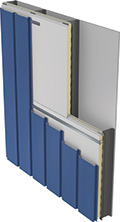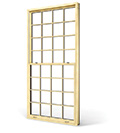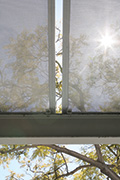FORWARD FACING: Innovations that are Moving Building Enclosure Design, Fabrication, Installation and Performance in Bold New Directions
Attaching the panels is typically achieved using standardized attachment systems. Some allow for simple snap-in-place possibilities while others are based on a removable design making it possible for subsequent changes to be made easily to the exterior facade. Either way, 3D aluminum composition panel systems have been tested using ASTM 330 “Standard Test Method for Structural Performance of Exterior Windows, Doors, Skylights and Curtain Walls by Uniform Static Air Pressure Difference.” Under the procedures of this test, the 3D panels have performed impressively at over 135 psi. Manufacturers indicate that they are durable and offer a 20- to 30-year finish warranty. Henry Bilge, CEO of ACPExpress notes, “Three-dimensional aluminum composition panels have been developed as a world-class product for exterior cladding.”
Textile Facades
An alternative to rigid metal or other materials used on facades is to take a different approach that relies on an open mesh material to create the visual outer appearance on a facade. Known as textile facades, they are a relatively new concept in the United States but have been used for some time elsewhere. To be clear, they are not usually a cloth textile, rather, they are made from a flexible composite material, but the term textile facade has become the generic way to refer to them. “While textile facade usage is common in other parts of the world, the United States is just now discovering the many benefits of its use,” says Jim Driggs, Serge Ferrari North America’s Business Development Manager.
There are a number of good reasons to consider using textile facades, not only for aesthetics, but also to improve the overall building performance. They are incredibly versatile, lightweight, flexible, printable, and 100 percent recyclable. As a shading device installed over windows, they can improve thermal comfort by reducing the heat load on the building. They also provide visual comfort by reducing glare without obstructing the view to the outside. With mesh openings on the order of 20 to 30 percent, they still allow natural ventilation to pass through while adding a degree of privacy and visual screening for windows.


Photos courtesy of Serge Ferrari
The textile facade on the new FBI offices and parking garage in San Diego provides an intriguing and elegant appearance that blends in well with the surroundings while meeting the client needs for security.
Textile facades can be used on retrofits as well as new construction as a lightweight and cost-effective alternative to traditional cladding materials. They can be a minimally invasive way to cover large spans and dramatically change the overall appearance of a building, either as a continuous cover or in smaller modular panels- vertically, horizontally, or in 3D configurations. They can be installed in tensioned fixed frames or even be retractable. The flexible composite materials can easily achieve complex curvatures, making design possibilities virtually limitless. The material can be digitally printed for artistic or branding opportunities or images can be projected onto them. Integrating LED lighting can also dramatically transform the appearance, especially at night.
Composite mesh can be specified in a broad spectrum of designer colors, to be UV stable, with anti-mold and anti-mildew treatments. It can also be flame retardant as well as non-combustible. A 10-year warranty is available with a 20- to 25- year life expectancy being common. At least one manufacturer ensures exceptional dimensional stability and flatness with no re-tensioning required with a smooth finish that requires very little upkeep.
Exterior Finish Options
By now, it is becoming clear that while facades are an integral part of the building enclosure and need to be treated properly from a performance standpoint, the aesthetic and finish options can be quite varied, even endless. This is true in terms of colors and textures, but it’s also in terms of how the finish maintains itself over time.
An emerging trend is to specify and use self-cleaning and heat-reflective finishes on building facades. Such finishes help the building maintain its original look since they are formulated to be cleaned time and time again with rain water. As water hits the surface, it simply beads off the exterior and takes any dirt, grime, or soil in its path with it. Further, some of the same finishes use a mix of raw materials specifically chosen to reflect the sun’s heat and ultraviolet (UV) rays, thus lowering surface temperatures, reducing heat island effects, and saving energy. When used over continuous insulation or an exterior insulation finish system (EIFS), the whole system is more effective at stopping thermal bridging and meeting current and anticipated energy codes.

Photos courtesy of Parex
Among the wide range of exterior finishes available, the use of self-cleaning, heat reflective finishes in many colors and textures have become an emerging trend.
Notice

www.acpexpress.com

www.buildabetterbarrier.com

www.fibertite.com

www.metlspan.com

www.parex.com

www.pellacommercial.com

www.sergeferrari.com

www.tubeliteinc.com









